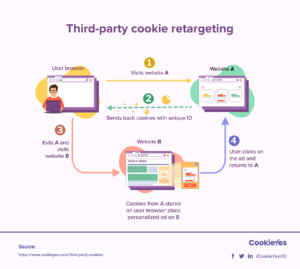How to Respond to the Loss of Third-Party Cookies
We’ve been encouraging marketers to focus on developing a strategy to wean their media plans and martech stack off third-party (3P) cookies for some time (and we still are!)
But if your organization hasn’t yet made it a top priority, Google’s countdown to phasing out third-party cookies in Chrome by Q3 2024 may be the push you need to move this to the top of your to-do list.
Here’s a closer look at what the potential loss of third-party cookies really represents, and actionable steps marketers can take now to respond.
What are third-party cookies?
Let’s start with the basics. Third-party cookies are text files that store data about web experiences across different websites, and help inform companies about the people who visit their own websites.
In the past, marketers and advertisers used third-party cookies to track who interacted with their site so that they could serve up ads to them across channels. Tracking individual user interactions over time also lets marketing teams understand the typical customer journey, and which campaigns or touch points lead to sales.

It’s important to note that websites can still collect first-party cookies from Chrome users, which are site-level insights stored by the website. For example, companies can store language preferences and login information plus track analytics like pages visited and bounce rates. The line between first- and third-party cookies is that first-party cookies stay in your website’s ecosystem while third-party cookies can ‘follow’ your customers across the web.
Other privacy rules that email marketers should know
In the realm of omnichannel marketing, trust is a two-way street. In one direction, marketers need a verifiable view of customers to provide relevant content and campaigns. In turn, customers want to interact with companies that know who they are and what they want, respect their privacy, and can deliver consistently great experiences with the least friction possible.
The loss of third-party cookies in Google Chrome is part of Google’s Privacy Sandbox Initiative, which aims to block covert data tracking while still empowering online businesses to serve relevant ads.
The upcoming cookie changes come after a few privacy legislation and policy changes in the past handful of years:
GDPR
General Data Protection Regulation (GDPR) is a European Union law that went into effect in 2018 that requires companies to collect affirmative consent from email subscribers.
The California Consumer Privacy Act (CCPA)
The California Consumer Privacy Act (CCPA) is a law in the state of California that went into effect in 2020 that gives Californians transparency and control over how their personal information is used by businesses.
Mail Privacy Protection (MPP)
Apple’s Mail Privacy Protection gives people the option to withhold their IP address from senders so that their activity and location can’t be tracked.
The loss of third-party cookies isn’t the first change that marketers have contended with, but it may be one of the most impactful. In fact, an Epsilon study of US marketers found that 69% of marketers across industries say the elimination of third-party cookies will have an even greater impact than GDPR and CCPA.
While we’ll certainly miss the heyday of third-party cookies and their wealth of behavioral data, we can use this tectonic shift as an opportunity to accelerate digital transformation through a blend of innovative and time-tested marketing strategies.
What happens when marketers lose third-party cookies?
About 80% of marketers in the Epsilon survey said they depend on third-party cookies, which are used for more than just serving ads. When they are gone, it could disrupt key components of your digital marketing ecosystem, including:
- Personalization: Behavioral and browsing data will be limited, making it harder for marketers who depend on third-party cookies to personalize ads
- Campaign Management: Basic capabilities like A/B testing and frequency capping could be more challenging for marketers who depend on third-party cookies
- Performance Marketing: Analytics and attribution based on third-party cookies could be much less effective. When you can’t measure what is and isn’t performing, it’s hard to prioritize your efforts or advocate for more team budget.
Questions to identify third-party cookie reliance:
In the 2024 State of Email survey, we asked marketers how prepared their company is for the end of third-party cookies. 38% of teams said they are poorly or very poorly prepared, and another 30% aren’t sure. If you’re in either of those camps, assessing your current third-party cookie reliance can help. Finding where you lean on outside data gives you a better sense of the work ahead of you.
Here are some questions to use to prepare:
- Do you connect with people based on third-party cookies or device IDs?
- If you have an identity solution, does it use multiple identifiers or just one?
- Do you use third-party cookies to gather signals and data about people so you can serve them relevant ads?
- Does your third-party data targeting use third-party cookies?
- How will losing third-party cookies affect your attribution measurement?
Answering these questions might feel intimidating and that’s okay. As you work through the details you’ll be empowered with the insights you need to create a present-day—and future— roadmap for where to focus.
It also helps to look at how your vendors are responding to the upcoming loss of third-party cookies. Jaina Mistry, Director of Brand and Content Marketing, shared how the Litmus team is preparing for the change:
“At Litmus, we have been reviewing which types of cookies our key vendors use to provide their services to us, to ensure we’re still able to execute our marketing strategy. The good news is, because the disappearance of third-party cookies is SUCH a big deal, the majority of vendors have been on top of making changes to their platforms to migrate away from third-party cookies to second-party cookies.”
Ways to respond to third-party cookies disappearing
Without a doubt, third-party cookies disappearing will shake up your marketing strategy. But if you look at it as an opportunity to grow and evolve, you can make positive changes that lead to user experiences that are just as relevant (or better!) than strategies that rely on third-party cookies.
1. Make first-party data your top priority
First-party data is customer information that you collect through your own channels, essentially swapping third-party details for home-grown insights. And it just so happens that email is the perfect place to collect first-party data through subscriber interactions. There are even opportunities to collect zero-party data, which is self-reported. You can’t get more accurate and reliable than that.
Here are a few ways to collect first-party data through email:
- Litmus Personalize Live Polls: dynamic live polls in emails are a fun addition that boosts engagement and lets you collect data on subscriber preferences
- Interest signals: tracking how many subscribers click on an image or link in your email provides social proof and an opportunity to send targeted follow-up messages based on a subscribers’ selection
- Subscription preference centers: offer subscribers a place to customize their account details like interests, preferred frequency, location, job role, team size, and more to create segments for targeting.
A trove of context-rich data will help your marketing team improve conversion rates on your owned channels and deliver a better customer experience. As part of this, you may want to invest in a Customer Data Platform (CDP), which makes it easier to aggregate a single view of your customers and take action on those insights in real time.
2. Prioritize time-tested marketing channels that deliver the highest ROI
Understanding the performance of all your marketing channels is critical to driving conversions, pipeline, growth, and customer engagement.
Time-tested channels, like email marketing, deliver an ROI of $36:1, making it one of the most effective, high-performing marketing channels in your marketing toolbox today, and a proven customer engagement strategy that drives conversions. In fact, 41% of marketers say that email is their most effective marketing channel.
By opting into your communications, your email subscribers have invited you into their inboxes and given you explicit permission to connect on relevant content and offers. As you evaluate your omnichannel strategy, consider putting email first in your marketing mix to create personalized experiences, increase engagement with your campaigns, and improve performance of your overall marketing mix.
3. Invest in contextual targeting
There have never been more ways to personalize emails with tools like dynamic content and AI recommendations than right now. Contextual targeting, where content is shown based on the content around it, doesn’t need third-party data to be relevant. Here are a few examples of live and dynamic content you can use to create relevant emails:
- Countdown timers to drive urgency
- Progress bars to keep customers motivated and informed
- Personalized images to create a personal touch at scale
- Sentiment trackers to gauge audience reactions
- Dynamic maps to your nearest stores
- Real-time sales showcases
- AI product recommendations based on past purchases
4. Collaborative data initiatives with industry partners
Your company and audience are unique, but your team isn’t the only one that has to navigate the loss of third-party cookies. Working with partners can help you make up for lost data.
Someone else’s first-party data is your second-party data, and it can come from sources like co-marketing efforts, customer reviews, and loyalty programs. You may be able to set up partnerships to share first-party data with other organizations in your industry to fill in knowledge gaps about customers.
The loss of 3P cookies is also a perfect motivator to cross-pollinate between channels and use email’s first-party data to create experiences between marketing channels. If you’ve shied away from or struggled with cross-channel collaboration in the past, now is the perfect time to rework your omnichannel marketing strategy.
Start building a future-proof marketing strategy
Marketers might still have a little more time to respond to a future without third-party cookies, but not much. As we move through 2024 there will be an industry-wide focus on re-evaluating how you personalize, and how to ensure you’ve got the data you need to move forward in a cookie-less world. Marketing leaders need to focus on driving performance over the next 12 months, while simultaneously building a long-term customer strategy that will carry their companies through the next five years.

Cynthia Price
Cynthia Price is the SVP of Marketing at Litmus
